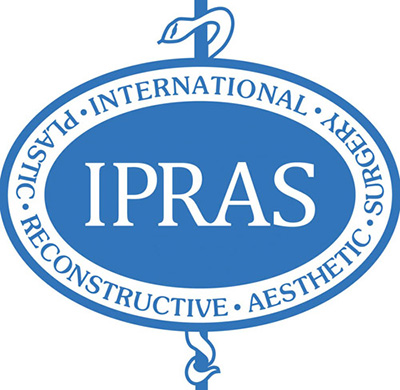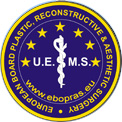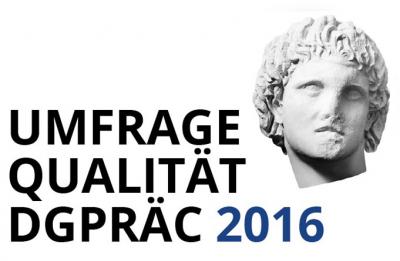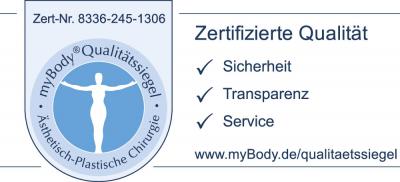Breast implant removal: Why?
The breast surgery experts in Düsseldorf give you all the answers
Information on breast implant removal
- Treatment duration: approx. 2 hours
- Anaesthesia: General anaesthesia
- Hospital stay: 1 to 2 overnight stays
- Downtime: approx. 1 to 2 weeks
- Costs: from € 4.500,- (plus anaesthetic costs)
In general, there can be many reasons for the removal of breast implants:
- Disorders related to the actual implant: mechanical damage or a tear in the implant shell, for example. In modern breast implants with a silicone body made of coherent gel (known as "cohesive" silicone) this does not lead to "leaking." Nevertheless, damaged implants must be removed.
- Excessive formation of a connective tissue capsule ("capsule fibrosis") around the implant: hardening, deformation, pain and reduced mobility of the breast are often the result. This pathology is known as "capsule fibrosis," the causes of which can be numerous.
- Individual sensitivities: Some patients start to feel that they want their implants removed. There are different, individual reasons for this, which do not always have to have a medical cause. If this removal takes place together with the capsule, it is called "en bloc" implant removal. The removal of breast implants together with the connective tissue capsule surrounding them (en-bloc implant removal) is a topic that is currently receiving more attention, especially in social media. However, the medical benefit is controversial. Learn more about en-bloc implant removal and breast implant disease ("Breast Implant Illness") in our blog post from January 2020!
- The presence or suspicion of a "BIA-ALCL": This is a very rare subtype of lymphoma within a breast implant capsule. The occurrence of this disease, which is classified as malignant, is associated with a certain type of implant that has been withdrawn from the market in Europe and the USA. However, the statistical probability of this disease occurring in females with this implant type is extremely low. Worldwide, it is currently estimated that there are 0.35 to 3 cases per million females with implants per year (source: Deutsches Ärzteblatt 2018). BIA-ALCL therapy involves the complete removal of the implants as well as the capsule, which means the affected persons are often cured.
Would you like to have your implants removed?
Do you have questions about breast implant removal or would you like to make an appointment online? Please contact us.
The human body reacts to the formation of a connective tissue capsule with foreign bodies of all types, whether they are breast implants, vascular or joint prostheses, dental implants or skin piercings. Delicate capsule formation from connective tissue is a normal process for any foreign body. It is neither visible nor palpable and does not normally lead to health problems. Only a firm and thickened capsule of connective tissue (known as „capsule fibrosis“) makes itself negatively felt through pain and deformation of the breasts. Older productions of breast implants with this strong capsule formation were regularly observed. Over time, as they were filled with liquid silicone, it leaked out of the thin shells; albeit only in small quantities. This process is called „silicone bleeding“, which is a strong stimulus for the formation of capsular fibrosis. It should be noted, the industry is constantly working to improve the safety and compatibility of implants. For example, liquid silicone is no longer used today. Nevertheless, all the implant manufacturers might have a capsule formation in modern implants over time. But what causes painful fibrosis? There are different theories about this. The most probable cause seems to be bacterial colonization of the implant shell, which may have been caused by the insert or via the bloodstream. The bacteria settle into the capsule and maintain the immunological process of defence so that more and more capsule tissue is formed. In order to prevent colonisation of the implants with pre-existing bacteria during insertion, a „14-point plan“ has been developed in breast surgery to ensure maximum safety and sterility during breast augmentation. This 14-point plan should be followed carefully by every breast surgeon who uses implants. It goes without saying that our plastic surgery experts at the Medienhafen in Düsseldorf strictly adhere to this plan for every operation in which silicone implants are used. The operation takes place under general anaesthesia during a one to two-day stay in the clinic. The implant is removed over the existing scar. If there are hardenings of a normally tender connective tissue capsule around the implant and a capsule fibrosis is present, this is also removed. Capsules consist of the body's own connective tissue, which can be left in place as long as there are no hardenings or even calcifications. In the course of time, the body dissolves the capsule tissue again, since the stimulus from the foreign material is missing. In this case, an „en bloc implant removal“ may be desired, whereby implants and the capsule surrounding them are removed in one go. With the surgical removal of the capsule tissue, the body's own tissue is also removed at the same time, so more volume is inevitably lost. This should be considered in advance. If the skin of the breast is sagging due to a lack of volume, the implant removal can be easily combined with a breast lift and/or a simultaneous volume increase by means of autologous fat transplantation. Whether such an additional procedure is necessary or recommended for you, will be detailed in a consultation at our practice in the Media Harbor Düsseldorf. There are only a few real medical reasons for the complete removal of an implant capsule. One reason is the presence of the very rare BIA-ALCL. Another is the presence of a high-grade capsule fibrosis with calcification of the capsule or leaked silicone filling in the case of implants from old manufacturing dates. However, complete removal of the capsule can also relieve the patient, fulfilling a psychological need rather than an actual medical benefit. In this case, if an en-bloc implant removal helps to improve the psychological well-being of a patient then we will do all we can to provide this comfort. A complete removal of the implant capsule is possible with implants that lie over the large pectoral muscle. The capsule is surrounded by sufficient soft tissue so that it can be removed without danger. If the implant lies under the large pectoral muscle, the capsule may not be removed completely and safely. For example, if the capsule is directly connected to the periosteum of the ribs or the intercostal space. In this situation, capsule removal can lead to increased bleeding and/or lung collapse and should be avoided if at all possible. The risks of an implant removal are the usual risks and possible complications of any breast surgery. This is why all operations should be performed by experienced plastic surgeons with proven expertise in breast surgery. Over the past 15 years, three of our specialists have performed approximately 500 breast operations a year in one of the region's major health care clinics, about a quarter of which have been performed on patients with breast implants. In a detailed and individual consultation we will be happy to inform you about breast implant removal and develop the ideal treatment plan together with you. The costs for an implant removal can only be roughly estimated in advance. They start at about € 4,500. These costs increase depending on the amount of work involved and the extent of the additional service, e.g., an additional implant capsule removal, a simultaneous volume increase by means of an autologous fat transfer („lipofilling“), and/or an additional breast lift. Together, we can estimate your individual treatment and service plan in an initial consultation.1. What is meant by capsule formation in an implant?
2. How does the removal of the implants work?
3. Can an en-bloc capsule removal, including the implant, be performed in any case?
4. What are the risks involved in implant removal?
5. What are the costs?












